INDIANAPOLIS — If Caleb Williams was as comfortable meeting with the Chicago Bears at the NFL scouting combine as he was engaging with the media Friday, a courtship leading up to the April 25-27 draft could go swimmingly.
The Bears were the talk of the combine. They own the first and ninth draft picks, they have the resources and opportunity to do whatever they please in free agency and they have a decision to make with incumbent quarterback Justin Fields. And Williams was the second-most discussed subject.
10 thoughts after a week in the Circle City.
1. Caleb Williams hit all the right chords when discussing his approach to leadership.
USC quarterback Caleb Williams kisses the Heisman Trophy during a news conference after winning the award on Saturday, Dec. 10, 2022, in New York. (AP Photo/Eduardo Munoz Alvarez)
The USC quarterback noted the Bears aren’t a run-of-the-mill team with the No. 1 pick, and he effectively explained why he chose not to work out or submit to medical testing on the trip.
His initial meeting with the Bears on Wednesday was limited to 20 minutes, and they’re sure to get together again this month — maybe more than once. At the end of nearly 13 minutes of questions and answers, Williams was asked what he wanted to find out about the Bears.
“Just, do you want to win?” he replied. “That is it.”
It was the only moment in which Williams zigged when he should have zagged. He has the wrong question. What he should be prepared to ask general manager Ryan Poles, coach Matt Eberflus and Chairman George McCaskey — presuming he gets an audience with the big boss — is “Do you know how to win?”
That’s the issue for the Bears in the early stages of a fascinating offseason. Whether they can satisfy Williams with their answer really doesn’t matter. They own the top pick and they’re going to do with it what they want, whether their answer resonates with Williams or not.
As expected, Williams put to rest months of questions about whether he wants to play for the Bears. That wasn’t something the team feared. I had a GM tell me a couple of months back, when his team had a scout on the USC campus in a room watching film with representatives from multiple teams, that Williams made an impromptu visit.
“Just so you know, none of that stuff out there was said by me,” Williams told the group of scouts, loosely referencing wide-ranging rumors that have followed him since the summer.
He seems comfortable with the idea of calling Lake Forest home.
“The Bears were a 7-10 team,” Williams said. “That is pretty good for a team that has the first pick. And they’ve got a good defense. They’ve got good players on offense and it’s pretty exciting if you can go into a situation like that.”
He’s right. It’s not a dysfunctional mess at Halas Hall like the Carolina Panthers are sifting through. They earned the No. 1 pick with a calamitous 2-15 season but had to send the pick to the Bears to satisfy the terms of last March’s blockbuster trade.
But a desire to win isn’t what has held the Bears back for the longest time. They’ve had one winning season in the last 11 years and have won one playoff game since their loss in Super Bowl XLI after the 2006 season. They haven’t had consecutive winning seasons since 2005-06.
No one is a bigger fan of the Bears or wants to see them succeed more than McCaskey, who would prefer nothing more than to make his 101-year-old mother, Virginia, proud of his ability to guide one of the league’s cornerstone franchises. This isn’t Major League Baseball, in which a portion of owners don’t commit the financial resources to compete and a canyon exists between the teams that spend and those that don’t. Massively lucrative media rights deals, a salary cap and minimum spending keep NFL teams on equal footing — from a metropolis like Chicago to a 108,000-population city like Green Bay.
The Bears’ thirst for success isn’t the issue here. They simply haven’t had the first clue of how to go about winning, so what Williams really should be asking is how they plan to do so. What else do they have in mind to point the organization toward the sustained success Poles rightfully talks about?
The Bears are champions at selling mediocrity as the cycles have grown longer between brief successes. How else can you account for the feel-good buzz they attempt to project coming off a seven-win season? I’m not saying there wasn’t tangible improvement, but they still brought up the rear in the NFC North and there’s a lot of ground to close between them and the Detroit Lions and Green Bay Packers.
It has become so easy to blame Justin Fields, Luke Getsy, Ryan Pace, Matt Nagy, Mitch Trubisky, John Fox, Jay Cutler, Marc Trestman, Phil Emery, Jerry Angelo, Lovie Smith, Smith’s revolving door of offensive coordinators and everyone else who has come through the franchise since the second Super Bowl appearance in franchise history. Who hasn’t been blamed? The lone exception might be Mike Ditka, and he was fired 31 years ago, so the Bears in fact cast blame on him as well.
It’s premature to judge whether Poles and Eberflus, who has overhauled his offensive staff, know how to lead the Bears to a position where they can consistently contend for NFC titles and the Lombardi Trophy. Poles can draw from his experience in Kansas City and recall every process the Chiefs went through before trading up and selecting Patrick Mahomes in 2017. That Williams has been compared in many ways to Mahomes is intriguing and explains why the Bears have been doing homework on the quarterback for months. Eberflus pointed out earlier in the week he has been studying quarterbacks his entire life. He should know one when he sees one, right?
As Poles moves through his third offseason in his position, it’s fair to say he has done a solid job of player procurement. Not every move has been a hit, but the Bears are loaded with young players and it’s reasonable to forecast growth for a good percentage of them. The defense is a player or two away from being really good.
Poles does a good job of projecting his message, and there’s little doubt he could provide a satisfying answer for Williams if asked how he plans to go about winning. Ultimately, that’s what Williams should be wondering if he has questions for the Bears and the other teams that will spend time doing draft research on him.
“Likable kid,” said one GM who met with Williams during the week. “No idea why we did. We’re not getting him.”
The Bears probably are getting Williams. They need to spend more time with him. They need to see him perform at his pro day and they could schedule a private workout. They surely will schedule him for a top-30 visit and get the requisite medical information he could have supplied at the combine. Plenty of due diligence is required.
If Poles and his staff watched Williams in front of the media — and surely they have by now — they likely came away impressed.
“I want to go to a place that wants to win,” Williams said. “A whole 360, all the way from the top down to the janitors and people that make everything run. Everybody wants to win, everyone is part of that and we all take care of each other.”
He seems to know his part. Maybe the Bears will figure out how to win. That has been the problem for the longest time.
2. This isn’t a 10 Thoughts devoted solely to Williams.
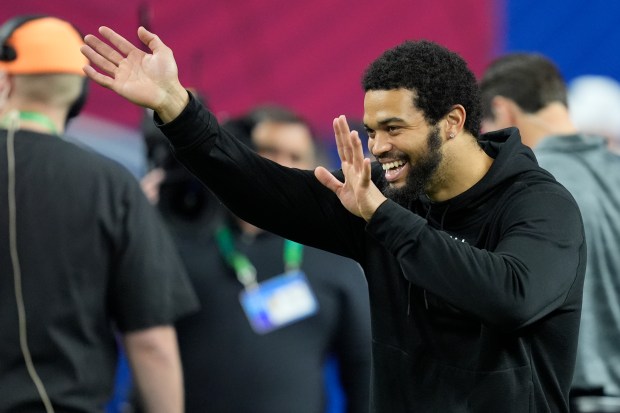
But there’s a lot to get at here and in the weeks and months ahead. In 24 years of covering the team, I’ve never felt as if I knew who the Bears were going to land in the draft like this — not in the first week of March.
The Bears need to have a plan in place to develop Williams — yes, we’re assuming they will select him — and that is a piece many have wondered about since the decision was made in January to retain coach Matt Eberflus. The same will hold true if they pivot and choose a different quarterback at the top of the draft.
There was curiosity at the end of the season if the team would consider shifting to an offensive-minded head coach knowing that a quarterback would likely be atop the team’s draft class. That didn’t happen and the Bears have expressed confidence in the moves they have made. They hired offensive coordinator Shane Waldron, passing game coordinator Thomas Brown, quarterbacks coach Kerry Joseph and offensive assistants Ryan Griffin and Robbie Picazo, the final two charged with working with quarterbacks and wide receivers.
Figure the team brings in a veteran quarterback for the roster at some point. I’ve wondered if Drew Lock could be a target based on his experience under Waldron in Seattle but they may look for someone older with more tangible experience. Williams told ESPN’s Pete Thamel he’s been working out with a group including Nathan Peterman, who has been the Bears’ No. 3 quarterback the past two seasons. Perhaps they’ve formed a meaningful bond.
There’s going to be a lot more behind the scenes that goes into handling, developing and putting Williams in a position where he can be at his best. Probably more than I can even imagine at this point. It’s going to require a building-wide effort.
“The question isn’t should they take the player?” said an assistant GM for another club. “He’s that good. The question is do they have the infrastructure in place to handle Caleb Williams and everything that will come with him?”
I can guarantee you the Bears will profess to be fully equipped to nurture and develop Williams. I promise you they’re going to put a lot of thought into precisely what is important. We’re not going to know if they’ve accomplished those goals until things really get rolling.
“It’s with all of the top-drafted quarterbacks, every one of them,” the assistant GM said. “They’re all coming in and they have an expectation of this or that. I’ve seen it with two quarterbacks now where I’m at. So, it becomes a deal where you have to give them what appears to be important to them without taking away from everything you’ve put into your foundation and your core beliefs and everything you’ve built. This guy is going to need to feel the love and believe he’s in the best place for him or eventually the entire thing is going to crumble.
“But there is a fine line here where you can’t give him too much. You can’t possibly give him everything he wants or is asking for because before long the rest of your team and everyone else in the locker room is going to see it and they’re going to say, ‘This guy can get away with anything he wants here.’ And if that happens, the entire thing is going to crumble.
“Do the Bears have everything in place they need to handle this? I don’t know. Guess you’ll find out.”
3. I am not sure where Justin Fields will land, but the vibe last week was he almost certainly will be traded.
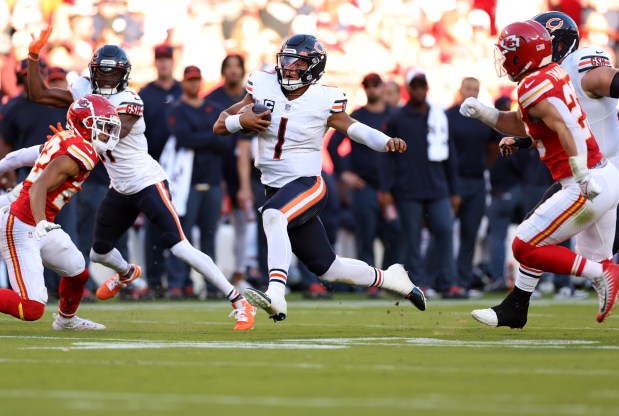
Chicago Bears quarterback Justin Fields scrambles in the third quarter of a game against the Kansas City Chiefs at Arrowhead Stadium on Sept. 24, 2023. (Chris Sweda/Chicago Tribune)
As freely as Ryan Poles spoke about the possibility of dealing Fields and his desire to “do right” by the quarterback in that scenario, it’s difficult to envision a path for him to remain as the team’s starter.
By the end of the week, multiple sources I spoke with suggested Poles was really at ease, with one talking about a golf simulator he had set up in his hotel suite. The message they delivered was Poles didn’t strike them as an executive who was feeling any pressure to hammer out a deal. Two sources wondered aloud if he had the bones of a deal in place. Maybe. Maybe not.
Connecting the dots to where Fields could go is tough. I don’t view the Pittsburgh Steelers as a great option. Some believe new offensive coordinator Arthur Smith will want to lure Ryan Tannehill there because of his experience in the system. The Las Vegas Raiders don’t make sense. Offensive coordinator Luke Getsy spent two seasons trying to make it work with Fields.
Are the Atlanta Falcons an ideal destination? Offensive coordinator Zac Robinson came from the Los Angeles Rams and worked under Sean McVay. Getsy came from the Green Bay Packers and worked under Matt LaFleur. LaFleur’s coaching tree comes directly from the McVay/Kyle Shanahan tree.
In other words, these are similar offenses unless Robinson wants to make some significant changes to what he was accustomed to with the Rams. But the Falcons need to do something to replace Desmond Ridder and with the No. 8 pick, they might not get a quarterback they want without trading up.
The Bears’ opportunity for a trade will be enhanced if the Minnesota Vikings manage to re-sign Kirk Cousins. That would take Cousins off a potential list for the Falcons. I don’t think Fields is an option in Minnesota if the Vikings lose Cousins.
One well-connected agent wondered if the New England Patriots loomed as a possibility. The Patriots could be drafting a quarterback at No. 3. I’m just not sure there is a robust market. Credit to Poles if he has created one.
If Poles had an offer he liked — even though deals cannot be made official until the first day of the league year on March 13 — it probably would be public right now. My hunch is maybe the Bears can get a third-round pick for Fields, and if they have a better offer, they probably should shake hands and call it a deal.
Keep an eye on how this unfolds because we’re talking about a potentially impactful draft pick, as the Bears currently lack a second-round draft pick. As I wrote coming out of the Senior Bowl, the feeling is talent is going to drop off on Day 3 of the draft. This shapes up as a really good first round of the draft but when you talk about depth — picks in Round 5 and later — it’s not as exciting. With the Bears needing to fill a multitude of spots, it could be a key pick they get back wherever it is.
4. An unprecedented spike in the salary cap probably won’t have a significant impact on the Bears.
Justin Jefferson of the Minnesota Vikings during a game on Oct. 1, 2023. (AP Photo/Rusty Jones)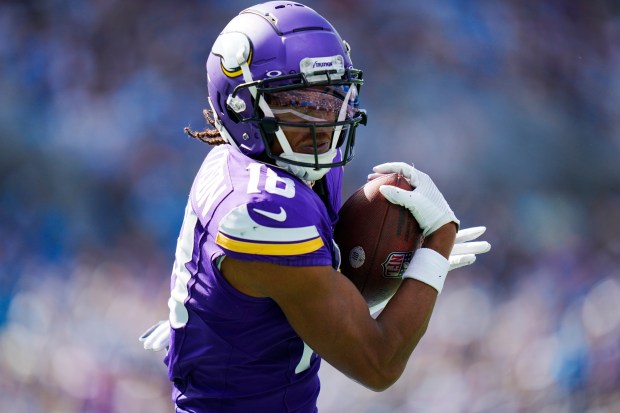
The cap was bumped up by $30 million to $255.4 million for the 2024 season. That could make competition more difficult for free agents the Bears earmark.
The Bears have roughly $66.6 million in effective cap space, according to overthecap.com, which accounts for things such as the money and cap space that will be required to sign a team’s draft class. That’s the fourth-most effective cap space in the league behind the New England Patriots ($79.3 million), Tennessee Titans ($69.6 million) and Washington Commanders ($68.3 million).
So Ryan Poles has all the cap space he needs to be as much of a wheeler and dealer in free agency as he desires. Before explaining why I would not expect a spending frenzy when the league year begins March 13, let’s dive a little deeper into the big-picture ramifications of a 13% bump in the salary cap.
The cap spike is a big win for teams such as the Super Bowl champion Kansas City Chiefs, Green Bay Packers, Baltimore Ravens, Cleveland Browns and a handful of others that were going to be right against the number or mighty close to it. All of this is fluid and teams are clearing space almost daily with contract restructures and releases. Those teams now have some breathing space, even if they need to do more cap work.
One veteran agent predicted the higher cap would create a situation where teams can be placed in one of three groups:
A) Teams that want to be active and sign a free agent or two to a good-sized contract.
“This is the bucket where you’re going to find most of the teams in the league,” he said. “Reality is there will not be enough good players in free agency to go around for everyone that wants one or two or whatever, but this is where most teams are going to find themselves.”
B) Teams that want to clear their books.
A $30 million rise — instead of, say, a $12 million bump — gives a nice head start to teams looking to eat dead cap space and reset their salary cap situation. There probably won’t be many teams in this category, but it’s a viable use for teams that might not be ready to be super competitive and have messy books projecting to 2025 and beyond.
The agent pointed to the Minnesota Vikings — if they are unable to re-sign quarterback Kirk Cousins — as a team that could be in this bucket. No one will openly declare they’re choosing this avenue because it’s more of a play for the future.
C) Teams with a cast of young players they want to extend.
Some teams are rarely significant players in free agency. They still can put the extra space to good use by committing it to players they want to extend. Teams also could roll over more future cap money than usual, maybe thinking about a 2025 extension or future free-agency dollars.
It’s amazing to see how the cap has taken off. It was $198.2 million in 2020 and $155.2 million in 2016, meaning it has risen more than $100 million in eight years. A source who works for a team — not a player representative — reasoned the biggest impact would be on the teams that would be scraping to create operating space for next season. He didn’t foresee anything dramatic.
His point was that it’s faulty to look at the cap in a vacuum for just one season. That’s an HOV lane to cap hell and not how teams approach it. From the team side, the question is more like: “How does this cap increase affect the next two to three years?”
“If the cap only climbs $10 million next season,” the source said, “then what?”
Every agent in town was seeking a meeting with the Bears, knowing they are flush with cap space. I didn’t get the impression the team was talking to everyone. They have needs, no question, but they’re a little better defined than they were a year ago.
My guess is the biggest contract the Bears will write in the next couple of months is for cornerback Jaylon Johnson. This should count as money spent in free agency, too, because while Johnson isn’t coming from another team, the Bears would be spending that money to prevent him from leaving via free agency.
Poles will be calculated in free agency, but my sense is they’re not chasing any of the guys who will command huge paydays. Maybe I’m wrong, but the timing for that doesn’t seem right if they’re going to draft and start a rookie quarterback.
In the long run, the expanded cap will help the rich get richer. It will affect a second contract for a player such as Vikings wide receiver Justin Jefferson. It probably helps Johnson in his bid to reset the cornerback market.
“Players making less than $8 million per year, they’re going to see almost no change,” the agent said. “Nothing for the middle class.”
5. Just reading the tea leaves, I think we’ll be looking at a four-year contract for Jaylon Johnson.
Chicago Bears cornerback Jaylon Johnson returns an interception for a touchdown during the fourth quarter against the Las Vegas Raiders at Soldier Field on Sunday, Oct. 22, 2023. (Trent Sprague/Chicago Tribune)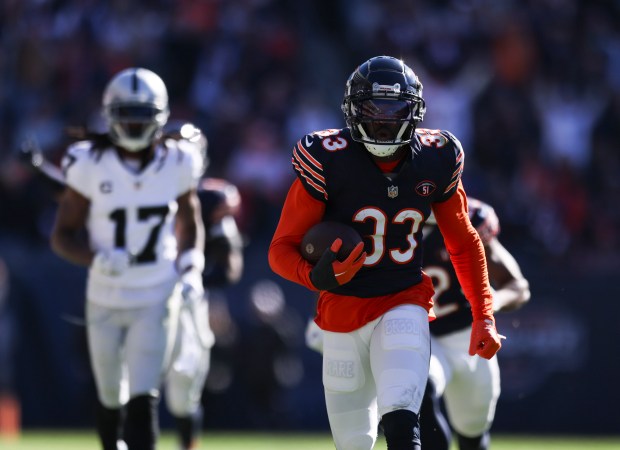
No deal is done, but at least one party — the Bears — believes it’s making a good-faith effort to close a deal before having to resort to the franchise tag.
The clock is ticking because the deadline for teams to use the tag is 3 p.m. Tuesday. Absent a signed contract, completed physical and all that, I fully expect the Bears to keep Johnson in place with the franchise tag before that deadline.
If and when a deal is done, I think it will be a four-year contract for a couple of reasons. For starters, that’s the longest contract the Bears have done under the current regime. Tight end Cole Kmet, defensive end Montez Sweat and kicker Cairo Santos received four new years in their extensions. Middle linebacker Tremaine Edmunds got a four-year contract in free agency.
Next, Ryan Poles hinted at Johnson completing his next contract before he turns 30. Johnson will be 25 on April 19.
“There’s a really good opportunity to go back to the market again and continue to earn money and play well, and hopefully that’s with the Bears for a long period of time,” Poles said. “Like I’ve said about those deals — all the time — it takes two to tango and you’ve got to find a place that everyone feels comfortable with, so I feel really good about that situation.”
Poles knows — with rare exceptions — players generally don’t cash in big time via free agency when they are on the wrong side of 30. So if the Bears get a four-year deal done with Johnson, he would become a free agent again after the 2027 season, right before he turns 29.
What could a four-year deal for Johnson look like? The franchise tag figure is $19.8 million, so that’s the floor (more likely the basement) for an annual average salary. Surely, Johnson would receive an average of $20 million or more, a territory only three cornerbacks have reached: Jaire Alexander, Jalen Ramsey and Denzel Ward.
Given the jump in the salary cap, it’s easy to imagine Johnson eclipsing Alexander’s $21 million annual average that tops the cornerback market. Four years, $88 million? Just a guess.
6. Sometimes it works out where a team’s need matches up well with the strength of the draft.
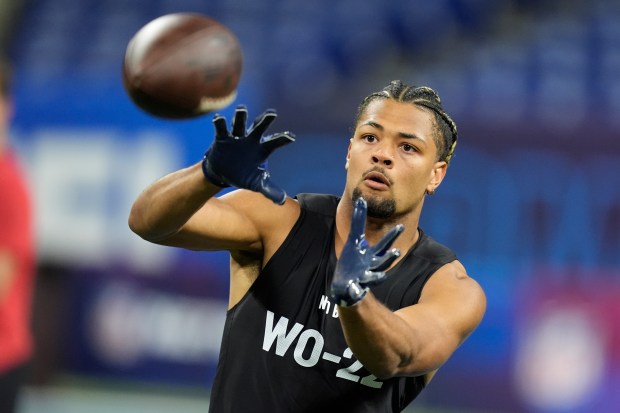
That’s the case for any club in the market for a wide receiver.
It looks like a banner class for wide receivers. I’ve written multiple times over the last couple of months that there has been entirely too much focus on one option — Ohio State’s Marvin Harrison Jr. That’s not a knock on him as a prospect at all. The point is there are probably three receivers in the upper echelon of prospects with Harrison and that group includes LSU’s Malik Nabers and Washington’s Rome Odunze. All three profile as legitimate No. 1 receivers.
In my initial mini mock draft before the combine, I had the Bears landing Odunze at No. 9 overall and it’s worth wondering if he will still be on the board at that point. As I wrote in that piece, the more quarterbacks selected in the top eight picks, the better chance the Bears have of landing their preferred target at No. 9.
I was curious what evaluators think about the next tier of wide receivers after the top three. What does that group look like? How deep is it?
“The next bubble is probably five to seven players,” one source said. “That’s as we sit here today.”
The list of names in that tier will be a little different from team to team and it’s not inconceivable that 10 receivers are selected in the first 50 picks or so. That is where it’s tricky for Ryan Poles. The Bears don’t own a second-round pick and after No. 9, they don’t pick again until No. 75 — the 11th pick in Round 3. That’s another reason why it’s important to keep an eye on what the team might be able to get in return for Justin Fields.
Maybe Poles will be in a position to trade down from No. 9 and get a receiver from the second bubble if Harrison, Nabers and Odunze are all off the board.
Teams are working to dig in on Nabers some. He was arrested on Bourbon Street in New Orleans in February 2023 and charged with illegally carrying a weapon. According to NOLA.com, charges were dropped on the condition that the seized gun would not be returned to Nabers.
“Based upon the lack of a previous criminal background and the individual currently being enrolled in college, we did not proceed with the misdemeanor gun-carrying charge against him at this time in exchange for his immediate and voluntary forfeiture of the firearm,” the district attorney’s office said, per the report.
Charges or not, gun issues are heavily scrutinized by NFL teams and Nabers will have to explain himself.
I’m relatively confident you can pull players for the second tier of wide receivers from the following 11 names: Keon Coleman (Florida State), Malachi Corley (Western Kentucky), Troy Franklin (Oregon), Xavier Legette (South Carolina), Ladd McConkey (Georgia), Adonai Mitchell (Texas), Ricky Pearsall (Florida), Brian Thomas (LSU), Tez Walker (North Carolina), Roman Wilson (Michigan) and Xavier Worthy (Texas).
Worthy set a combine record by running the 40-yard dash in 4.21 seconds, one of nine players at the position to run a sub-4.4 time. Thomas (4.33), Mitchell (4.34) and Walker (4.36) are particularly interesting.
There is a solid group of veterans in free agency and that list is headlined by Mike Evans of the Tampa Bay Buccaneers. Calvin Ridley, Hollywood Brown, Darnell Mooney, Gabriel Davis, Tyler Boyd, Kendrick Bourne and Curtis Samuel are all expected to be available. One GM predicted money would dry up quickly in the free-agent market for receivers as teams eye the possibility of drafting players at that position.
Mooney could have a better market than some who follow the Bears expect. I don’t think teams are going to hold his lack of production in 2023 (31 receptions, 414 yards, one touchdown) against him knowing that Justin Fields didn’t work to his back-side reads very effectively. There’s a cautionary tale here for Mooney as he turned down an extension offer from the Bears before last season started. As I understand it, Mooney had a three-year deal worth more than $10 million annually on the table. It will probably be hard for him to approach that on the open market. Credit to him for being a stand-up guy all season. You didn’t hear Mooney gripe about a lack of opportunities and that will resonate to a degree with teams in free agency.
7. The Bears still have more work to do on the offensive line.
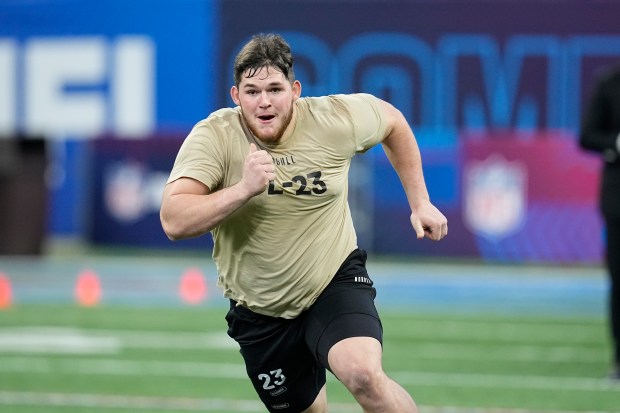
It’s been a year since they fortified the offensive line by selecting right tackle Darnell Wright with the 10th overall pick and signed right guard Nate Davis to a $30 million, three-year contract.
The question is, how much more work is needed? Do the Bears like the idea of investing heavily at wide receiver with draft capital or adding an offensive tackle? If there is an early run on wide receivers, perhaps the Bears look closely at a potential left tackle. I wouldn’t rule out the possibility of them also drafting a right tackle and exploring Wright on the left side. A lot will depend on how the Bears evaluated left tackle Braxton Jones and what kind of trajectory they see him on.
One thing I’d love to know … if all things are equal and there is a left tackle with a draft grade that is nearly identical to a wide receiver, which one is Ryan Poles choosing? I can make a strong case in either direction.
The Bears need to get a center and, lacking a second-round pick, it might be difficult to get a plug-and-play rookie at the position. There are some intriguing possibilities and folks I have chatted with really like West Virginia’s Zach Frazier, but he’s going to come off the board somewhere between the back end of Round 1 and the middle of Round 2.
The top option in free agency could be Denver’s Lloyd Cushenberry and it sounds like he will be able to command north of $10 million per season, which is where the top centers in the league are. Do the Bears want to pay that kind of money to a position that lags behind others in terms of pay?
“Good player and he’s gotten better but no one wants to pay centers,” is what one GM told me.
Connor Williams of the Miami Dolphins might have been the No. 1 center in free agency but a torn ACL late in the season complicates the picture with him. He turns 27 in May and while I don’t think there is concern about him recovering from the injury, it’s still an issue. It’s beyond when will he be able to play in 2024, too. How confident can a team feel about the medical situation for Williams at the outset of free agency? The last thing Poles wants to do is get himself in another situation like he encountered with defensive tackle Larry Ogunjobi at the opening of free agency in 2022. The Bears had a deal in place with him before he took a physical and the Bears failed him because of a foot injury. Poles and Co. had to pivot and by the time this was done, a lot of players the team might have otherwise considered were off the market.
Here’s one name that makes me curious. What about Mitch Morse? The Buffalo Bills are in a bad spot with their salary cap and are going to have to get creative to become compliant by March 13. If Morse is cut — he’s got one year remaining on his contract with a cap figure of $11.5 million — or traded, are the Bears interested?
Morse turns 32 in April and he entered the league as a second-round pick of the Kansas City Chiefs in 2015. Poles knows him well and he might be an ideal candidate to play traffic cop on the offensive line and work with a rookie quarterback. I don’t know if Morse comes free. The Bills would, no doubt, prefer to keep him but Buffalo has some tough decisions to make in the next week or so. If the Bears got Morse, he could hold down the fort for a year or two and buy some time for the team to find its next long-term option at the position.
8. The Bears will focus on one trait in seeking a defensive end to join a mix with Montez Sweat and DeMarcus Walker — speed.
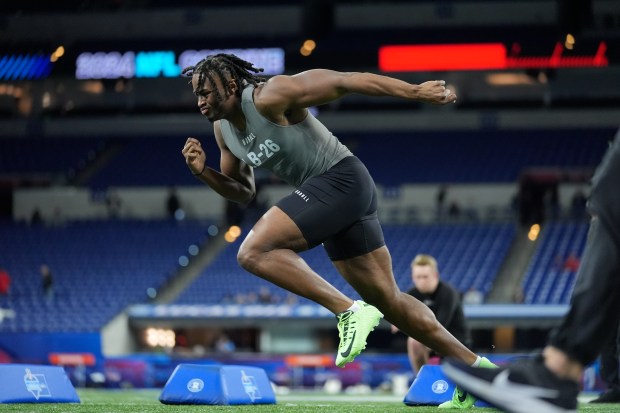
Yes, Sweat has plenty of speed and ran a 4.41 40-yard dash at the combine when he came out in 2019. He’s an all-around end, plays with plenty of power and is a rugged run defender as well. Walker is more of a traditional left end in a base 4-3 scheme and his pass-rushing skills are best highlighted from the interior in the sub package. What Matt Eberflus and new defensive coordinator Eric Washington need is a player who can fly off the edge, even if it’s just in clear passing situations. That would complete the group, especially if the team can boost the rush from the inside as well.
A couple of players were flying last week and four defensive ends had sub-4.6 times — Alabama’s Dallas Turner (4.46), Penn State’s Chop Robinson (4.48), Colorado State’s Mohamed Kamara (4.57) and Florida State’s Jared Verse (4.58). Turner, Robinson and Verse are all first-round picks and, yes, the Bears could potentially have their choice of the first defensive player to come off the board at No. 9. Is that the direction they would want to go if they are drafting a quarterback at No. 1 and want to put him in the best position to succeed immediately? Kamara has some inconsistencies and profiles as a late Day 2 pick maybe.
But I think speed is the thing to focus on here. Is it something the team could seek in free agency? Possibly. I’d hesitate to connect the Bears to any of the options that are going to command huge money in free agency. It might not be ideal to have big money in two defensive ends. The Bears would much prefer to have Sweat paired up with a cost-effective option, in my opinion.
Connecticut’s Eric Watts did well in the 3-cone and short shuttle drills and he ran a 4.67 40. He’s got excellent length at 6-foot-6, 274 pounds and Eberflus always puts a premium on that trait. He’s a Day 3 possibility but the Bears would be betting on development with him.
Think about speed off the edge when wondering what could be in store in free agency or the draft.
9. There’s a lot the Bears can get into with Caleb Williams when they meet with the quarterback moving forward.

You wonder if at some point — in some conversation — they talk about the Notre Dame game. USC was completely overmatched in a 48-20 loss to the Irish on Oct. 14. It was the first loss of the season for the Trojans and things sort of spiraled from there. Williams completed 23 of 37 passes for 199 yards, one touchdown and he was intercepted three times. Notre Dame totaled six sacks.
Ryan Poles was in attendance for that game and the Irish game plan by defensive coordinator Al Golden mirrored in at least some ways what the Cincinnati Bengals did against Patrick Mahomes in the AFC Championship Game following the 2021 season. Cincinnati scored a 27-24 overtime victory to reach the Super Bowl in part because of in-game adjustments. Golden was the linebackers coach of the Bengals at the time.
The Irish completely dominated in October and the biggest takeaway should be that Notre Dame won the game in the trenches. They overmatched an underwhelming Trojans offensive line. From a schematic standpoint, Notre Dame emphasized keeping Williams in the pocket with a level pass rush. They didn’t want edge rushers crashing hard inside and allowing him space and time to make plays.
On the back end, the Irish did something they hadn’t done all season.
“We had a funky game plan that day,” Notre Dame cornerback Cam Hart told me at the Senior Bowl. “It was a different coverage we didn’t normally run but we perfected it and we got after it. We called it Keef. It was Cover Two to the field, it was Four locked to the boundary. But we had so many checks, so many rotations. It was formational based. There was a lot of communication going on, talking every play. It was advanced for sure.”
Why Keef?
“Chief Keef?” Hart guessed. “I have no idea where the name came from. Cover Two and Cover Four, those are things that we always run. But how we did it that game was different. The nuances, the communication, the checks, the calls, what we were doing in motions, what we were doing in certain formations. That was the thing we had to pick up on and we were all locked in. We knew it was a rivalry game. We knew that week it was going to be on.”
Defenses have adjusted to Mahomes throughout his career. They began playing a lot of two-high safety against him to eliminate the big plays to Tyreek Hill when he was in Kansas City. Mahomes and Andy Reid adjusted and the Chiefs began picking apart defenses underneath. They’ve found answers for just about everything and Williams will no doubt encounter schemes and coverages in the NFL he hasn’t seen previously. He’ll need to adjust — something the Trojans coaches didn’t do at Notre Dame Stadium that night. I imagine Williams and Poles can have an interesting conversation about that game.
10. Tying up loose ends.
• Any team picking in the top 10 of the draft that is set at quarterback is viewed as a possibility to trade out. It’s even possible some teams with a quarterback need (New England at No. 3) could be on the move.
• One of the most thought-provoking comments I heard all week was when Ryan Poles credited the assistant director of player personnel for saying there are two categories for quarterbacks — artists and surgeons.
• Personnel men say some pretty solid veterans have already been cap casualties and more are certain to come. That can spruce up free agency a little bit.
• One coach on how much he believed former offensive coordinator Luke Getsy shifted what he was doing to spark the offense:
“You think 18 quarterback runs in a game was part of his offense?” he said. “That’s tailoring the offense. Is there a path to winning nine, maybe 10 games with Justin Fields? Yeah, but everything would have to be perfect. I think if you dropped him into Philadelphia he could win maybe 10 games. Would have to stay healthy.”
• It will be interesting to see how the Bears fill the hole at free safety. They’ve got some experienced players on the back half but I wonder if Matt Eberflus will prefer a veteran for all of the communication that has to take place. One scout wondered aloud if Jordan Fuller of the Los Angeles Rams would be a good fit for the Bears. He had three interceptions, eight pass breakups and three forced fumbles last season.
• Last season, the NFL announced the teams for the extra preseason game at the Pro Football Hall of Fame during the combine. There was no word last week on which teams will be playing in that game this year. The Bears are bracing for the possibility they play four exhibitions instead of three.
• No word yet on which opponent the Bears will face when they play in London during the regular season. One possibility is the Jacksonville Jaguars, who will be playing a home game at Wembley Stadium. The Jaguars played two games in London last season and it’s possible Jacksonville double-dips abroad again. The Bears have a home date with Jacksonville on the schedule.



